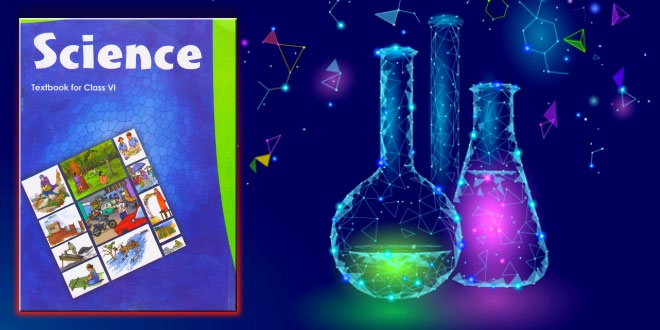Light, Shadows and Reflection – 6th Class NCERT CBSE Science Chapter 11
Question: We see the sun rising 8 1/4 minutes after it has risen. Why?
Answer: The speed of light is 3 lakh per second. The sun’s raise take time to reach on earth.
Question: Name two sources of light and two man-mad sources of light.
Answer:
- Man-mad source of light are: Tube light, candle.
- Source (natural) of light are: Sun, firefly.
Question: How do we see non-luminous objects?
Answer:
- Light should fall on the object.
- The object should reflect light towards our eyes.
Question: What is meant by ‘rectilinear propagation of light’?
Answer: It means that light always travel in straight line.
Light, Shadows and Reflection – Question: When is a shadow formed?
Answer: When the source of light is blocked with opaque or translucent object that forms shadow.
Question: Why does a solar eclipse always occur on new moon day?
Answer: When the sun, moon and earth are in a line and moon blocks the light it is solar eclipse. But half of the moon receives light and the other does not receive the light. Hence, the moon is not visible on solar eclipse day.
Light, Shadows and Reflection – Question: When can you see the image of an object in a plane mirror?
Answer:
- Light should fall on the object
- Object should reflect the light
- Mirror should reflect the light
- And the reflected light should reach our eyes
Question: List three properties of a shadow.
Answer:
- It is always on the angle at which the light falls.
- It always on the opposite source of light.
- It always shows the outline image and not the details of the image.
Question: In what ways is an image different from a shadow?
Answer:
Shadow:
- When a shadow is formed it is completely black in colour.
- A shadow is similar in shape to the object but never shows the details of the object.
Image:
- When an image is formed the colour remains the same.
- An image is not only of the same shape of the object but shows all the details of object.
Question: Draw a diagram to show the formation of the image of a distance tree by a pinhole camera.
Answer:
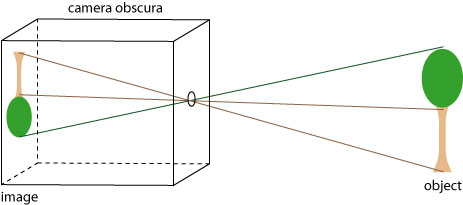
Question: Does a pinhole camera from an image or a shadow? Why?
Answer: It forms image from the light rays reflected by the object.
Question: Can you think of creating a shape that would give a circular shadow if held in one way and a rectangular shadow if held in another way?
Answer: Yes, there are many things which give a circular shadow if held in one way and a rectangular shadow if held in another way. For example: a cylinder, a circular disc etc.
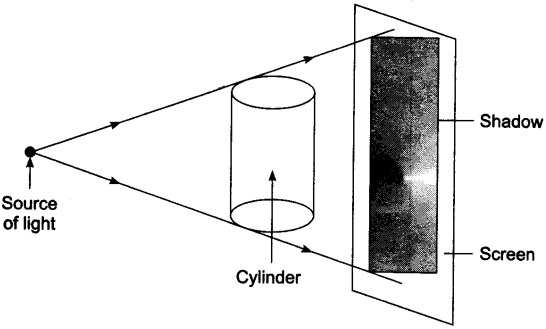
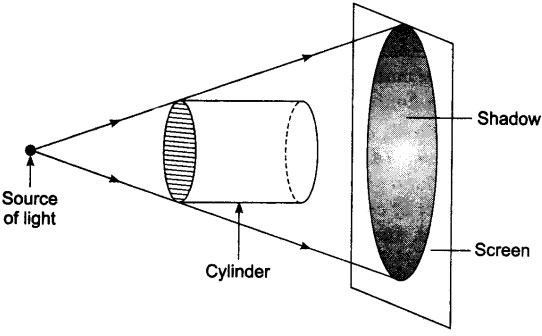
Question: In a completely dark room, if you hold up a mirror in front of you, will you see a reflection of yourself in the mirror?
Answer: No, in a completely dark room no image will be formed because there is no light in the room so no reflection of light takes place and no image will be formed.
Question: Whether the moon is luminous or non-luminous body?
Answer: Moon is non-luminous body.
Question: What is umbra?
Answer: Umbra is the dark region behind object facing light which does not receive light at all.
Question: How does a light ray travel?
Answer: Light ray travels in a straight line.
Question: Give one natural source of light.
Answer: Sun is a natural source of light.
Question: What is shadow?
Answer: Shadow is the dark space behind an opaque object where light does not reach.
Question: What is penumbra?
Question: State difference between a luminous and a non-luminous body.
Answer: The bodies which emit light are called luminous bodies. Example: sun, stars, burning candle etc.
The bodies which does not emit light are called non-luminous bodies. Example: moon, earth, blackboard.
Question: Why is the moon not considered as a luminous body?
Answer: Moon is non-luminous body because it shines by reflecting the sunlight falling on it.
Question: What is an incandescent body? Give example.
Answer: The bodies which emit light when heated to a very high temperature are called incandescent bodies. Example: electric bulb.
Question: When does a shadow form?
Answer: Shadow is formed when light does not reach behind the opaque object kept in the path of light
Question: Draw a diagram to illustrate the formation of umbra and penumbra.
Answer:
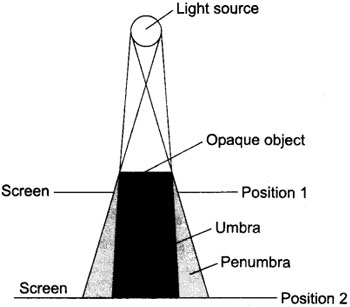
Question: What are the essential conditions for the formation of shadow?
Answer:
- There should be an opaque material.
- There should be a source of light and screen.
The object must be placed in the path of light. Then shadow is formed on the screen.
Light, Shadows and Reflection – Question: Define reflection of light.
Answer: When light rays after striking the smooth and shiny surface return to same medium, this phenomenon is called reflection of light.
Question: How will you convert a glass sheet into a translucent sheet?
Answer: There are following two methods to convert glass sheet into a translucent sheet:
- By smearing a thin layer of oil on glass sheet.
- By covering a side of sheet by butter paper.
Question: What is shadow? How does the colour of an opaque object affects the colour of the shadow?
Answer: A dark outline or patch formed by an opaque object that blocks light coming from a source of light is called shadow. The colour of an opaque object does not affect the colour of the shadow.
Question: Write the differences between umbra and penumbra.
Answer:
Umbra:
- It is the darkest part of shadow.
- No light reaches to this region.
- It is central part of a shadow.
Penumbra:
- It is less dark part of shadow.
- Light from some part of the source reaches.
- It is outer part of a shadow.
Light, Shadows and Reflection – Question: What do we need in order to see a shadow?
Answer: We need:
- A source of light
- A screen
- An opaque object.
Question: What do you mean by scattering of light?
Answer: When a beam of light falls on a rough surface it is turned back in different directions. It is called scattering of light.
Question: Have you ever seen an ambulance? It is written in the form of mirror image on vehicles. Explain why it is done so and give the mirror image of AMBULANCE.
Answer: The mirror image of AMBULANCE is ECNALUBMA.
It is written so on the vehicles for the people to see in their rear view mirrors, read it correctly and immediately give way to the vehicle as it carries patients who need urgent medication.
Question: You have to cost the shadow of your pencil on the wall with the help of candle in a dark room. How can you obtain the shadow of same size, small size and big size of the same pencil?
Answer:
- The shadow of the pencil will be small when the pencil is taken close to the wall and away from the candle.
- The shadow will be big in size when the pencil is taken closer to the candle.
- To get the same sized shadow as the pencil is, adjust the distance between the wall, pencil and candle at equal distances.
Question: What is reflection of light? Explain reflection of light with the help of an activity.
Answer: When light rays fall on a highly polished (Example: mirror) smooth surface and return to the same medium, it is called reflection of light.
Activity to show reflection of light: This activity should be done at night or in a dark room. Ask your friend to hold a mirror in his hand at one corner of the room. Stand at another comer with a torch in your hand. Cover the glass of torch with your fingers and switch it on. There should be small gap between your fingers. Direct the beam of torch-light on to the mirror that your friend is holding. Adjust the direction of torch so that patch of light falls on your friend standing in the room. This activity shows the reflection of light also that light travels in straight line.
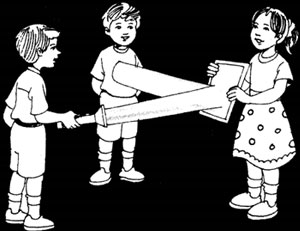
Reflection of light activity
Question: Explain the manner in which light travels with the help of an activity.
Answer: Take a comb and fix it on one side of a thermocol sheet. Fix a mirror on the other side as shown in figure. Spread a dark colored sheet of paper between the mirror and the comb. Send a beam of light from a torch through the comb. You get a pattern of light similar to that shown in figure. This activity explains the manner in which light travels and gets reflected from a mirror.
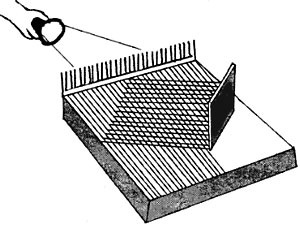
Question: Explain that light has the property of rectilinear propagation.
Answer: We take three pieces of cardboard. Place them one on the top of one another and make a hole in the middle of each cardboard by using a thick nail. Erect these cards up on the table at a short distance away from each other. Take a candle which is of the same height as the holes in the cards. Light the candle and place it in front of the cards. We see that the light of candle is visible only when the holes on cards lie in a straight line. If we disturb them the light of candle disappears. This experiment shows that light propagates in a straight line.

 Class Notes NCERT Solutions for CBSE Students
Class Notes NCERT Solutions for CBSE Students
